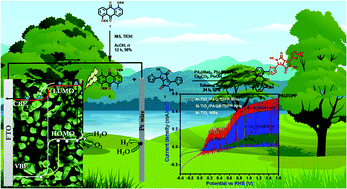Synthesis of diketopyrrolopyrrole and anthraquinone-based polymers of D–A1–D–A2 architecture by direct arylation polycondensation and designing inorganic/organic nano-heterostructured photoanodes for visible light water splitting†
Abstract
This article reports the synthesis of two polymers of donor–acceptor1–donor–acceptor2 (D–A1–D–A2) architecture employing the direct heteroarylation poly-condensation reaction. Both the first polymer (PAQTDPP) and the second polymer (PAQBTDPP) comprise anthraquinone (AQ) and diketopyrrolopyrrole (DPP) as the acceptor1 and acceptor2 components. In contrast, where PAQTDPP incorporates thiophene as the donor, PAQBTDPP incorporates the bithiophene moiety as the donor. Later, two n–n inorganic/organic nano-heterostructures (NHs)—N-TiO2/PAQTDPP and N-TiO2/PAQBTDPP—were fabricated using nitrogen-doped TiO2 nanorods (N-TiO2 NRs) and PAQTDPP and PAQBTDPP polymers on the fluorine-doped tin oxide (FTO) coated glass substrate. The N-TiO2/PAQTDPP and N-TiO2/PAQBTDPP NH materials were utilized as the photoanodes for visible light photoelectrochemical water splitting. At 1.23 VRHE, the N-TiO2 NR, N-TiO2/PAQTDPP NH, and N-TiO2/PAQBTDPP NH photoanodes exhibited a photocurrent density of 0.157 mA cm−2, 0.504 mA cm−2, and 0.397 mA cm−2 (@10 mV s−1), respectively, in a 0.5 M aq. Na2SO4 electrolyte. The inorganic/organic nano-hybrid photoanodes also exhibited cathodically shifted water oxidation onset potential compared to the N-TiO2 NR electrode. The augmented photoelectrochemical performances of the inorganic/organic nano-hybrid materials are attributable to the absorption capability of a broader spectrum of visible light by the polymers, suitable band alignment between the inorganic and organic components of the heterojunction, and better and faster-photogenerated charge carrier separation and transportation.



 Please wait while we load your content...
Please wait while we load your content...